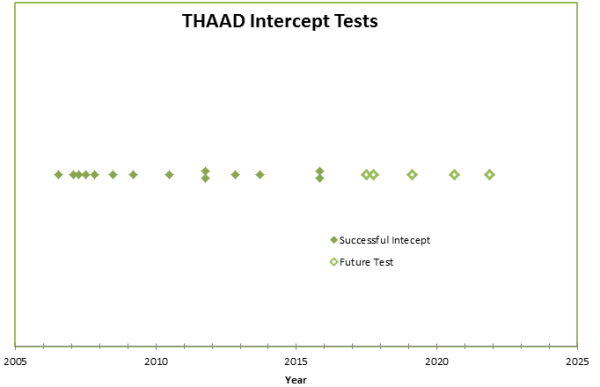Sea-Based Terminal
Most of the attention given the US Navy’s Aegis Ballistic Missile Defense (BMD) program focuses on its various versions of the SM-3 anti-missile interceptor. These missiles, the SM-3 Block IA, the SM-3 Block IB and the forthcoming SM-3 Block IIA, intercept their targets above the atmosphere and are intended to provide coverage over large areas (particularly the Block IIA). However, this post discusses the Missile Defense Agency’s and the Navy’s Sea-Based Terminal (SBT) program, which is developing and deploying lower-altitude, within-the atmosphere ballistic missile defense interceptors.
An SBT capability offers several possible benefits. First, it provides a second layer of ballistic missile defense for Navy ships and nearby areas, thereby potentially increasing the overall effectiveness of the Aegis BMD system. SBT interceptors operate in a completely different way than the SM-3 interceptors. The SBT interceptors home in on their target using radar, maneuver using atmospheric forces, and kill with a high-explosive fragmentation warheads, while SM-3 interceptors use infrared homing, maneuver using rocket thruster (divert thrusters), and kill using direct high-speed collisions. These differences in operating principles may make it less likely that a countermeasure (or other circumstance) that defeats an SM-3 interceptor can also defeat an SBT interceptor. Second, SBT interceptors can potentially intercept shorter-range missiles, such as Scuds (or longer range missiles on depressed trajectories) that do not leave the atmosphere (that is, rise above about 100 km altitude) and thus cannot be intercepted by SM-3 interceptors. Third, SBT interceptors are likely to be much less expensive, by a factor of three or more, than SM-3 interceptors. Finally, SBT interceptors can also be used to intercept aircraft (and soon ships), allowing more efficient use of the limited number of vertical launch tubes on Navy ships.
SM-2 Block IV, Block IVA, and Block IV (modified)
In the 1990s, the Ballistic Missile Defense Organization and the U.S. Navy planned to develop a terminal phase ballistic missile defense system known as Navy Lower Tier. (In parallel, BMDO was developing the Navy Upper Tier interceptor, which was renamed Navy Theater Wide, and eventually evolved into the current SM-3 Aegis BMD interceptors.) This program, which was renamed Navy Area Defense in 1996, was based on a new version of the Navy’s existing extended-range air defense missile the SM-2 Block IV. The SM-2 Block IV operates within the atmosphere, uses semi-active radar homing and has a high-explosive fragmentation warhead.
